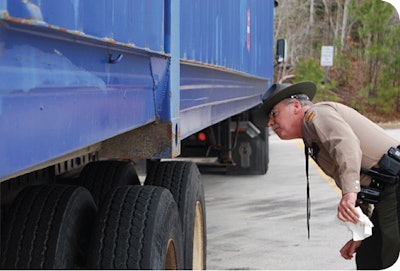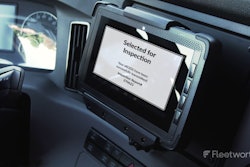More than a year after taking effect, the Compliance, Safety, Accountability program still frustrates carriers, drivers and others with what they believe are serious flaws.
 Inspections took on a new importance in December 2010, when the Compliance, Safety, Accountability program went into effect.
Inspections took on a new importance in December 2010, when the Compliance, Safety, Accountability program went into effect.Two issues that inspire most of the groaning are the absence of crash accountability in the measurement system and the weight CSA gives certain violations over others. A third is regional disparities in enforcement that put some carriers at a disadvantage.
The most immediate effort for change involves the highway funding bill, still pending at press time. Last month, members of the House and the Senate were deadlocked in a conference committee trying to flesh out a compromise version of a two-year funding bill. Some analysts say it’s an opportunity for the industry to lobby Congress to pressure the Federal Motor Carrier Safety Administration to change CSA.
FMCSA officials declined to be interviewed, but through a prepared statement the agency said it “considered developing a crash weighting initiative that would examine the responsibility associated with crashes involving commercial” vehicles, but that it needed to study further in “several critical areas.”
The biggest problem is over crash accountability, says Tom Bray, editor of Transportation Management for J.J. Keller & Associates. “The argument is, ‘We got hit by them. How come we’re being held responsible for it?’”

Regarding violation severity weighting disagreements, Bray cites examples such as relatively high values placed on not wearing a seatbelt and relatively low values assigned to brake problems.
Steve Bryan, founder of Vigillo, a company that helps carriers manage their CSA scores, says he sees a push outside of the highway bill to pressure Congress. “Ultimately, some of this may get embodied in a highway bill,” he says, “But I think there’s a separate initiative to just go to Congress and lobby.”
The American Trucking Associations’ stance, he says, “is it’s time to take the gloves off a little bit and see what we can do to make this thing better.”
Bray, though, doubts that pressuring Congress to force FMCSA to change CSA will work. “FMCSA is already doing what Congress has told them to do, and I don’t think Congress is going to step into the weeds and tell them how to do it.”
FMCSA is trying this summer to improve the overall system relative by moving load securement violations from CSA’s Cargo BASIC (behavior analysis and safety improvement category) into the Vehicle Maintenance BASIC. That leaves only hazardous material standards under Cargo, and that BASIC has been renamed Hazmat. The changes were expected to be effective this month, following the June 30 end of a preview available to motor carriers.
Some flatbed haulers’ scores in the Vehicle Maintenance BASIC, as expected, jumped with addition of securement-related violations, which are much more obvious in that segment than in dry van or reefer, for instance. With the removal of the Cargo BASIC, however, in some senses the change may be a wash for any overall rating, or Safety Fitness Determination, that is expected to come out of CSA in the future.
“If there are rules that have no statistical correlation to crashes, why are they regulations?”
— Brett Sant, Knight Transportation.
However, carriers who haul hazmat just often enough to meet the new Hazmat BASIC standard now will be inspected as such. Because some of their drivers aren’t regular hazmat haulers, some fleets could easily see an increase in their percentile rankings there.
That’s what Bryan discovered when his company ran advance simulations of the new methodology with data from its customers. “Many of the largest, safest, best-operated companies were finding themselves … over the threshold or having an alert in the new Hazmat BASIC, where really none of them had any alerts in the past,” he says.
Bray says FMCSA has acknowledged that the new category isn’t about safety as much as it is simply about compliance. FMCSA’s argument, Bray says, is that “if these rules aren’t followed, the effects of the crash are worse. The responders don’t know what they’re dealing with, the public is unaware of the hazard.”
There again, says Bray, “CSA was created to be about crashes. A lot of the hazmat violations have nothing to do with crash causation.”
ATA’s Rob Abbott says the trade group wants two things included in the highway bill: “That the DOT do not use crashes that the motor carriers did not cause and could not have prevented, and that carrier scores should only relate to risk of future crashes.”
Abbot says he also sees “regional disparities” as a major issue, and “in a system based on comparative scoring, it produces skewed results.”
Bryan says Louisiana, for example, writes more seatbelt violations than any other state, whereas other states may focus more on hours of service, log violations, lamps and tail lights or speeding.
“If I operate in Louisiana,” he says, “because a seatbelt violation has a relatively high severity weight, I’m subject to the risk of having a higher score than a carrier operating in the northeast. This creates an area of unfairness.”
Brett Sant, a safety vice president for Knight Transportation, says CSA is “fundamentally flawed.” Because the system is based on peer comparisons, using scores taken from so many varying levels of enforcement and posting them publicly erodes the program’s intent.
“You can’t take the flexibility away from the states,” Sant adds. “But at the same time, if you’re going to compare peers, you have to account for [disparities] in the scoring, and they don’t do that.”
He’s done a small study, too, in which he compared numbers of all of his fleets’ inspections and violations. In the two states with the highest violation-to-inspection ratio, there were about 1.7 violations per inspection. The two lowest states had a 0.3 ratio, meaning the most aggressive states are issuing almost six times as many violations per inspection as the least aggressive.
“It’s tough for the fleets that operate heavily in the states with more violations per inspection,” he says. “All other things constant, your scores are going to be much worse.”
Sant also says that while he and his fleet agree with the premise of CSA, everything embodied within the program should relate to safety, not compliance.
“If there are rules that have no statistical correlation to crashes, why are they regulations?” Sant asks. “I think the industry is really concerned, and justifiably so. What we’re seeing are things that indicate CSA is not, in many ways, as effective as it was touted to be.”
Sant says carriers like Knight risk getting caught up in trying to comply with CSA regulations rather than managing safety. “If compliance detracts from the focus on safety, is it really serving the interests of safety?” he asks.












